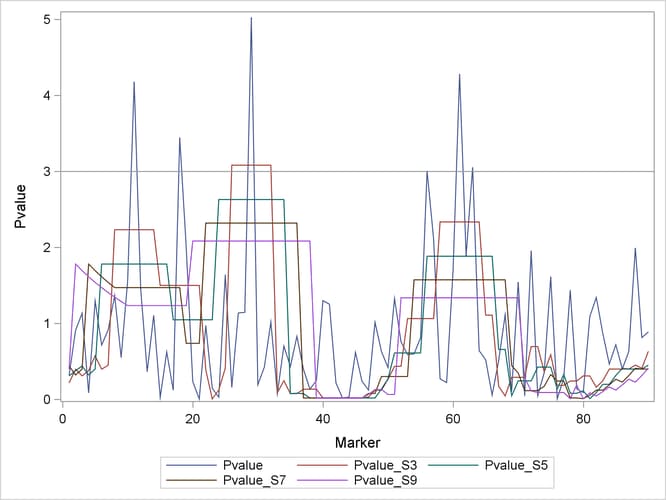The PSMOOTH Procedure
Data other than the output data sets from the CASECONTROL and FAMILY procedures can be used in PROC PSMOOTH; here is an example
of how to use ![]() -values from another source, read into a SAS data set by using the following DATA step.
-values from another source, read into a SAS data set by using the following DATA step.
data tests; input Marker Pvalue @@; datalines; 1 0.72841 2 0.40271 3 0.32147 4 0.91616 5 0.27377 6 0.48943 7 0.40131 8 0.25555 9 0.57585 10 0.20925 11 0.01531 12 0.23306 13 0.69397 14 0.33040 15 0.97265 16 0.53639 17 0.88397 18 0.03188 19 0.13570 20 0.79138 21 0.99467 22 0.37831 23 0.86459 24 0.97092 25 0.19372 26 0.85339 27 0.32078 28 0.31806 29 0.00655 30 0.82401 31 0.65339 32 0.36115 33 0.92704 34 0.49558 35 0.64842 36 0.43606 37 0.67060 38 0.87520 39 0.78006 40 0.27252 41 0.28561 42 0.80495 43 0.98159 44 0.97030 45 0.53831 46 0.78712 47 0.88493 48 0.36260 49 0.53310 50 0.65709 51 0.26527 52 0.46860 53 0.55465 54 0.54956 55 0.44477 56 0.04933 57 0.12016 58 0.76181 59 0.80158 60 0.18244 61 0.01382 62 0.15100 63 0.04713 64 0.52655 65 0.59368 66 0.94420 67 0.60104 68 0.32848 69 0.90195 70 0.21374 71 0.95471 72 0.14145 73 0.95215 74 0.70330 75 0.19921 76 0.99086 77 0.75736 78 0.23761 79 0.87260 80 0.91472 81 0.33650 82 0.26160 83 0.41948 84 0.62817 85 0.48721 86 0.67093 87 0.53089 88 0.13623 89 0.44344 90 0.41172 ;
The following code applies Simes’ method for multiple hypothesis testing in order to adjust the ![]() -values.
-values.
proc psmooth data=tests out=pnew simes bandwidth=3 to 9 by 2 neglog; var Pvalue; id Marker; run; proc sgplot data=pnew; series x=Marker y=Pvalue / lineattrs=(pattern=solid); series x=Marker y=Pvalue_S3 / lineattrs=(pattern=solid); series x=Marker y=Pvalue_S5 / lineattrs=(pattern=solid); series x=Marker y=Pvalue_S7 / lineattrs=(pattern=solid); series x=Marker y=Pvalue_S9 / lineattrs=(pattern=solid); refline 3.0 / axis=y; discretelegend; run;
The NEGLOG option is used in the PROC PSMOOTH statement to facilitate plotting the ![]() -values by using the GPLOT procedure of SAS/GRAPH. The plot in Output 9.1.1 demonstrates the effect of the different window sizes that are implemented.
-values by using the GPLOT procedure of SAS/GRAPH. The plot in Output 9.1.1 demonstrates the effect of the different window sizes that are implemented.
Note how the plots become progressively smoother as the window size increases. Points above the horizontal reference line
represent significant ![]() -values at the 0.05 level. While six of the markers have significant
-values at the 0.05 level. While six of the markers have significant ![]() -values before adjustment, only the method that uses a bandwidth of 3 finds any significant markers, all in the 26–32 region.
This can be an indication that the other five markers are significant only by chance; that is, they might be false positives.
-values before adjustment, only the method that uses a bandwidth of 3 finds any significant markers, all in the 26–32 region.
This can be an indication that the other five markers are significant only by chance; that is, they might be false positives.

